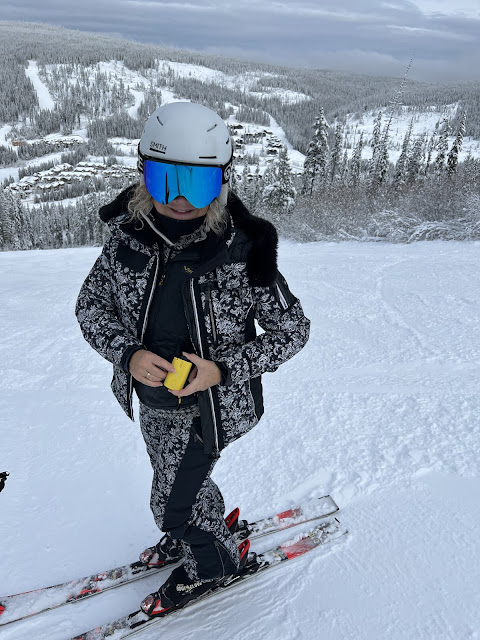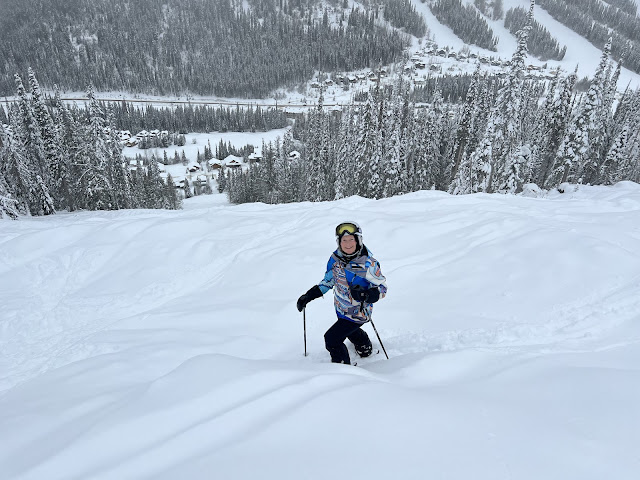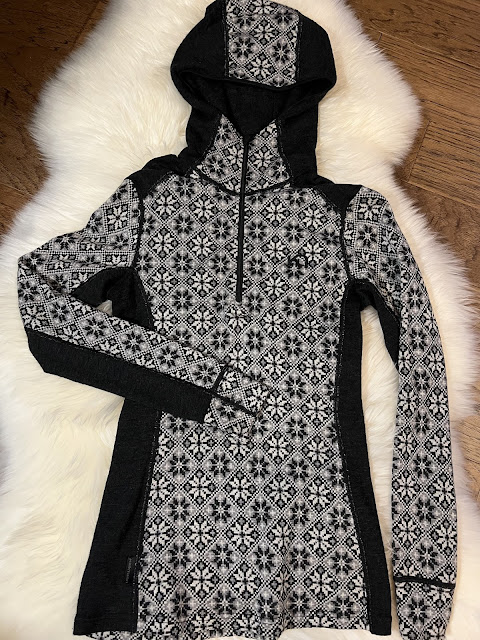I’m just getting ready for a day of ski guiding in minus 25 Celsius. Not an easy task, but I volunteer as a Sun Host, showing newcomers around Sun Peaks’ 4,270 acres of slopes - whatever the weather.
 |
| Helly Hansen shell with Lindsey Vonn’s HEAD Legacy ski pants |
Prep starts Sunday night when number 1 priority is recharging the batteries for my heated items: Volt mitts or Ororo gloves, Ororo socks, Volt vest, Volt 5v scarf or Ororo scarf, Therm-ic boot heaters. Packing a couple of the charging cables in my jacket pockets is a great idea so I can re-charge some of the depleted batteries if I find a handy socket at lunchtime.
 |
| Changing the 3-level heat setting on Ororo Heated Gloves (jacket by Alchemy of RIDE; goggles by Glade Optics; helmet by SMITH) |
Another trick, to make the heat last throughout a long day on the slopes, is to wear both heated socks and heated boots. Not to switch on at the same time, but to start with one on and then, when those batteries run out, swap to the other. This works with heated glove liners and heated mitts, too. And Smartwool merino glove liners inside heated mitts are also a good combo. If there was a lightning strike, I’d be toast! If you’re wondering whether to buy mitts or gloves, I can tell you for sure that mitts (with no finger separators inside) are the warmest. And make sure your heated mitts have a heated thumb.
 |
| Ramping up the levels on my Volt Heated Vest (suit by Obermeyer) |
Foot Protection
Boot Gloves are absolutely invaluable. Whether I wear heated socks or heated boots (or neither or both), I always add DRYGUY Boot Gloves over my ski boots. With heated footwear, it is only necessary to use the lowest setting with boot gloves on top, which means the batteries last longer into the afternoon. They are relatively affordable (around $40) and, paired with good thermal socks from Smartwool or Heat Holders, they provide an extra defense against cold, prevent snow leakage, and prolong hardiness during cold weather.
 |
| DRYGUY Boot Gloves |
But how do they work, you’re wondering? “The Boot Glove is made of neoprene which is in turn made of small closed cells that are filled with air, providing insulation against cold snow, water, and air by trapping heat in,” Cate Rodrigue, sales manager for Interex Industries explains. “Just like a wetsuit works in the water. The Boot Glove traps the relatively warmer air inside so although they are not providing heat - quality merino wool socks, natural body heat and good quality toe warmer products will do that - they perform by keeping that heat in, rather than letting it escape. Neoprene is also waterproof so the Boot Glove keeps cold snow or water away from the surface of your boot preventing the boot from essentially acting like a cooling device.”
 |
| My DRYGUY Boot Gloves in action |
Key to Layering
Next to attend to is the perfect layering. I wear a lot of layers on the coldest days but it’s important to determine which ones are best nearest the skin.
Heat Holders’ soft, fluffy base layers are usually my choice for tops and leggings. There are various thicknesses for the base layers to suit different weather.
The “Original” is so soft and fluffy, it’s like clothing yourself in Beanie Baby fabric. The “Lite” is slimline but still cosy. On minus 30 Celsius days I wear both just to be safe!
(https://www.heatholders.ca/collections/womens-baselayer)
My mid layer is a Kari Traa merino wool sweater with an integral hood that keeps the back of the neck fully covered and acts as a cosy helmet liner.
Next comes a heated vest which warms the chest and the back as though someone is giving me a warm hug - a toasty torso helps prevent loss of circulation and heat in the extremities.
 |
| Ororo’s new red heated vest |
A Smartwool merino long neck gaiter pulls up to act as a face mask, tucked under the edge of goggles. And I have a second one in a pocket in case of sogginess or, worse, frozen sogginess. Making sure every tiny area of skin is covered up is vital. If exposed skin goes numb and white, it’s the beginning of frost bite. No chance of a goggle tan in minus 30!
A heated scarf comes into its own during the deep freeze. Worn over the merino neck warmer, it keeps the back of the neck snug, also maintaining ambient blood flow to the head. So instead of suffering brain freeze through goggle gap when skiing or schussing fast, I’ll actually be the only hot head on the slopes.
Outerwear De-mystified
Outerwear must of course be windproof, waterproof, breathable and insulated. For windproofing, choose jackets and pants that are 1 CFM - 0 CFM / m²/sec. Waterproof ratings are calculated in millimetres and 20,000 mm is for the wettest weather conditions. For optimum breathability, go for 20,000 g/mm2. And for insulation, the fill power rating should be 700 + for the deep chill.
The Helly Hansen Sun Host uniform jacket I wear for my volunteer guiding (pictured at the top) is just a shell albeit a Goretex waterproof windproof shell with powder skirt and useful, helmet-friendly hood. But, at the risk of taking on ‘Telly Tubby’ proportions, I wear another insulated ski jacket underneath - either Obermeyer or Alchemy of RIDE. If I fell over, I would bounce. This might sound like a lot of clothing, but it’s the only way to ski all day in minus 20 C and below. These temperatures, fortunately, don’t happen too often in British Columbia but it is expedient to pack these items in case of a deep freeze.
 |
| Skiing West Bowl at Sun Peaks Resort in full sunlight wearing Glade Optics (Ski suit by Alchemy of RIDE) |
My favourite goggles for the coldest days are by Glade Optics from Breckenridge - they come with two different magnetic lenses, one for low light and the other for sunlight. Easy to pop on and off, they can be swapped whenever the visibility changes or if they fog or ice up. Less bulky than bringing a second pair of goggles which is something I have had to do in the past - especially once when heli-skiing with CMH Heli in minus 38!
If you’re in the market for a new pair, get your order in for the new Flylow X Glade Adapt 2-0 - no need for two lenses as the photochromic Adapt 2 changes tint to suit the conditions. And it’s guaranteed not to fog.
 |
| Sunburst Bar + Eatery at Sun Peaks Resort |
Slower skiing, more breaks
Skiing technique is also paramount. Going Mach 2, barely turning, and waiting for the terrain to slow you down is never a good game plan but in the cold it is even worse. The faster you ski, the more of your own personal windchill you’ll create. So slow down (the snow will be sticky anyway when it’s really cold), make many more turns than you would usually, treat the terrain as if it was moguls even if it’s not, and practice short swings in order to give your metabolism something to do, heating up muscles from the inside out. Choosing bumps runs or rugged off-piste terrain helps.
 |
| Cinnamon bun at Sunburst Bar & Eatery |
Regular warming-up stops are also mandatory. This is the time to sample the goodies in all the mid-mountain lodges (such as cinnamon buns at the Sunburst Lodge at Sun Peaks) - and use the hot hand dryers to dry your accessories. When toes feel frozen, remove ski boots in the lodge and massage them gently back to life. Don’t tread on the wet floor, though, as getting socks wet is not conducive to putting ski boots back on and the wetness will freeze outside. Don’t push the envelope, know your limits and retreat to indoor cosiness every hour or so. If possible, pick lifts with covers (like the Sunburst Chairlift at Sun Peaks) or the less wind-exposed lifts.
Ambient Après
And it’s not just during the day that the cold needs combatting. For après ski, it’s essential to have warm gear to get to all the best Happy Hours (half-price Wine Wednesday at Bottoms, for example). Footwear is fundamental and boots, both long and ankle-high, like Bos & Co’s Ice Grip varieties are necessary for tramping through snowdrifts or over icy patches. Using topnotch Portuguese leather - and also manufactured there - they come with wool linings, tweed accents, chunky grippy soles, and are warm to minus 25 C and waterproof. Bos & Co also sells animal-free Portuguese boots and slip-on shoes from the brand Asportuguesas, which have thick corrugated non-slip soles and fabric uppers.
 |
| Smartwool merino socks |
For added warmth, pair with Smartwool merino socks using their online Sock Finder to narrow the choices down to exact needs (https://smartwool.ca/en/sock-finder.html).
 |
| Heat Holders Ultra Lite Minimum Thickness Snow Sports socks for men and women |
A manmade fabric alternative is Heat Holders Ultra Lite Minimum Thickness Snow Sports socks with soft brushed inners. Using Japanese designed thermal yarn for softness and breathability, they have a short looped cushion pile which retains warm air giving the socks a 1.0 TOG rating (Thermal Overall Grade). Compare this to a basic cotton sock which would be around 0.33 TOG. The higher the TOG, the warmer the sock.
 |
| Volt Heated 3v Camp Slippers - looking cool while keeping warm |
And, if you don’t like clumping around in heavy duty footwear all evening, a compromise is the new heated 3v Camp Slippers by Volt. “We started with heated slippers over 10 years ago,” says Volt’s Chris Haffly. “We have had customers who have worn our other slipper styles over the years ask for a version which they could use outdoors. They also wanted something they could easily slide on and off so we came up with the Camp Slipper.” The rechargeable batteries give 3-7 hours of heat depending on the power level used and can be turned on and off by wireless remote.
Heat Holders makes thermal pompom hats, neck warmers and matching mitts for après ski (and daily winter wear) which are luxuriously lined with velvety HeatWeaver insulation. There’s nothing warmer or softer to the touch. And their spa robes are perfect for pre and post hot tub wallowing.
Magical Merino
Trying to understand the magic of merino - which is not very thick but somehow is still so warm - I asked Smartwool’s Tyler Stephenson what the secret is. “As a thermoregulating material, merino reacts to changes in your body temperature, perfect for insulation during physical activities like skiing or snowboarding,” she says. “In colder temperatures, merino provides warmth while wicking moisture away from your skin before it has the chance to turn to sweat. This allows the material to absorb moisture without sacrificing insulation.” With the wrong base layer fabric, you can sweat during exertion despite the cold temps and this can later turn to ice inside your clothing.
 |
| Cosy clothing by Smartwool |
Stephenson recommends merino for base layers, for glove liners and for beanies under helmets. And, for those trying to avoid helmet hair, the merino solves the problem, eliminating static. “This is likely due to merino’s natural properties,” she says. “It’s temperature-regulating and moisture-wicking; absorbing and releasing moisture that might typically affect your hair.” Her advice for all merino garments is to machine wash carefully and air dry to re-shape, extending the product life, and reducing environmental footprint.
 |
| Powder day at Sun Peaks Resort - photo taken on Wringer, our run home |





















